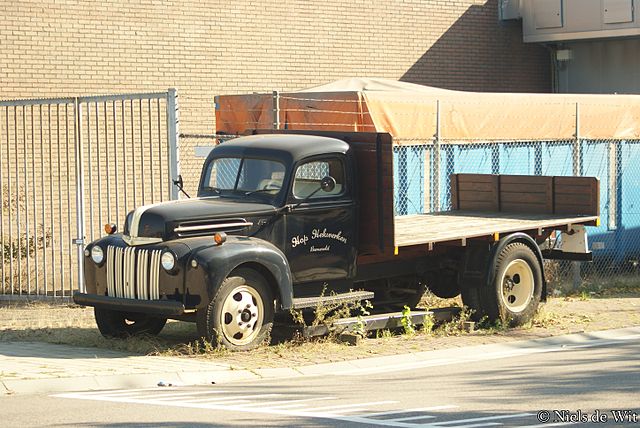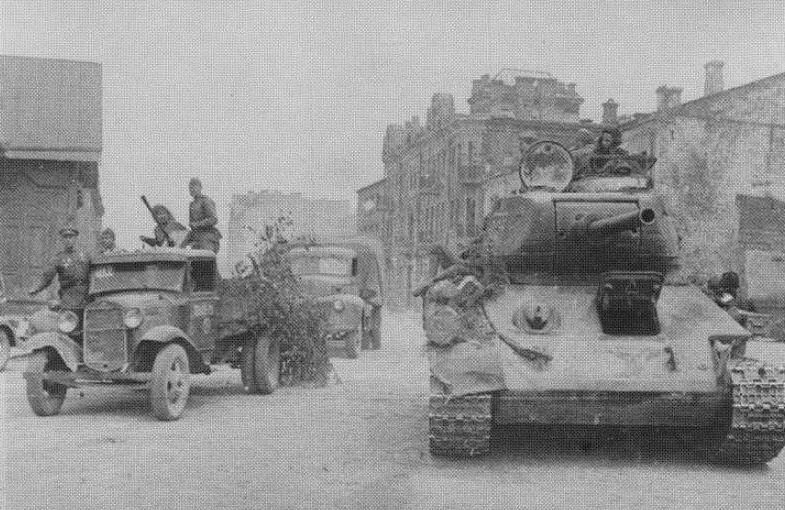Ford G8T (1942)
 USA (1942-45), medium truck, 61,000 built
USA (1942-45), medium truck, 61,000 built
Ford G8T ("Ford-6"), 1½-ton, 4x2, Cargo
 1944 Ford G8T "Jailhouse" in postwar service, restored today
1944 Ford G8T "Jailhouse" in postwar service, restored today
The Ford '6' was a fork of the 1942 Ford Commercial 3-Ton Truck ("Ford 6") which was used for the civilian amrket in the US, but the prospect of government subsidies to produce more for the war effort led to the design of a model that could be sold under lend-lease. Indeed standardization for the US Army ordnance department led to stick to a single 6x6 standard from Chevrolet (with the CCKW) and Dodge was retained for small trucks. Diamond provided specialized heavy duty models, but Ford concentrated on purely military vehicles in its factories. Still, a number of trucks were still available for export under lend-lease of needed.
Adn so was the "Ford 6", better known under its military designations 2G8T and G8T. The US Army eventually tested the vehicle and asked for some modifications for military use, but it was not intended to be pressed into the US Army. In case it entered the register as the Ford G8T, 1½-ton, 4x2, Cargo. In fact this model, by a twist of fate, became the number one lend-lease export truck to USSR. The model chosen for such production had a 158 inches (4 meters) wheelbase with the common 144 inches (3,6 meters) by 80 inches (2 meters) cargo body. To spare strategic materials, the first model was civilian and had a steel chassis in 1941. It was replaced after a relatively short production by a flatbed ending with a wooden back metal cargo space on the military. The model was called G8T in Army designation, but to separate the metal and wooden back vehicles, they became the 2G8T and G8T respectively.
the 2G8T was produced according to records usually found, to 17,000 units in 1941, until replaced by the military Ford G8T (61,000) produced until 1945, for a grand total of 78,000. The G8T by far became the most numerous commercial 1.5t 4x2 truck delivered to Russia under the Lend-Lease Act, starting in early 1943. The 2G8T differed not only by its steel chassis, but also by its engine type and some minor modifications, and apparently delivered as well, making the "Ford-6" (related to the engine's cylinders) the second most delivered truck to USSR. However whilst on the field, technical problems arose due to the high compression of the engine combined with the pure Russian fuel quality used. It was also stuck on roads and could not stand the rasputitsa.
Design
 G8T in the background, Minsk 1944
G8T in the background, Minsk 1944
The 2G8T and G8T were externally almost identical, but the military G8T was supplied with tow hooks and protection cramps on the headlights. They were shipped either complete and ready to operate or crated, with assembly set. They were mostly ship direct from the US via Groenland as poart of the dreadful Arctic Sea convoys, frequently attacked by Hitler's Kriegsmarine surface ships and U-Boats, or flying boats from the Norwegian coast.
But the losses were such there was an attempt to deliver them driving them ince landed in India, via Iran. Production of the G8T lasted until 1947 according to most sources, in the civilian market. It had the standard metal cab shared also by Dodge models, and a peculiar bonnet with the caracteristic vertical louvres, and streamlined but flattened forward mudguards integrating the standard lights and military blackout lights. Additios included a relocated spare tyre, utility storage boxes, apparatus to the transmission to fit a winch, and military tyres as well as reinforced leaf springs. The dashboard was "stock" but simplified, delivered with some non-essential dials missing.
Specifications
 Ford 6 1947 dashboard
Ford 6 1947 dashboard
The vehicle was delivered as a 4x2 cross-country truck with closed cabin, either with a back metal cargo-space (2G8T) or back wooden cargo-space (G8T). The first was in fact produced in Ford factories in Germany. Some were catpured and rused by the allies in North Africa. The G8T was a 4x2 2-ton truck having the following caracteristics. powered by a Ford V6, 3700cc, rated for 90hp at 3300rpm, Power/weight ratio of 29.7 hp/t. It had a Bore/Stroke of 83.82/111.76 mm with a compression ratio of 6.7:1. The clutch used a dry single plate and the gearbox was a constant 4 speeds, the differential ratio had a pair of bevel gears with spiral tooth. It had a clearance of 24.7cm, front wheel track of 1,47m, rear track of 1,65m, for a turning radius of 9.3m on right turn, front outer wheel track. It used 7.50-20 inches tyres. Suspensions were semi-elliptic.
Ford G8T specifications |
| Dimensions (L-W-H) | WB: 4.01m - 6.47 x 2.22* x 2.24* m |
| Curb weight, battle ready | 2,62 tons* |
| Crew | 1 driver + crew |
| Propulsion | Ford 6-cyl 3,700 cc, 90 hp |
| Top speed | 81.5-82 kph |
| Max range | 75 +114 L tanks, 23 L/100km |
*2,21 m wide and 2.06 m high for the 2G8T. 3,03 tons, 77 kph.
There was also another variant, the G8TA tractor, for a semi-trailer. This too, was massively exported via lend-lease to USSR.